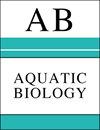环境对挪威北部亚北极陆架浮游动物丰度的影响
IF 0.8
4区 生物学
Q3 MARINE & FRESHWATER BIOLOGY
引用次数: 2
摘要
2013年9月至2014年8月,我们研究了挪威北部罗弗敦群岛大陆架上8个日期和5个地点的常见浮游动物丰度。我们测试了环境变化和丰度之间的关系。结果表明,在已记录丰度的17个浮游动物类群中,有4个杂食性或肉食性类群的丰度在站点间持续存在差异。这种差异可能反映了相对较深的水柱分布中心,这些物种的丰度与底部深度呈正相关。在10个分类群或类群中,丰度与采样日期、温度、盐度或荧光相关,但通常与底部深度无关。这些分类群大多是低营养水平的消费者,垂直分布通常与近地表水有关。在其余的分类群或类群中,丰度与环境或采样时间没有关系。研究结果表明,陆架上浮游动物丰度以中深垂直分布为主,主要受水深的限制,而以近海面分布为主的浮游动物丰度变化受年内环境变率的驱动。本文章由计算机程序翻译,如有差异,请以英文原文为准。
Environmental effects on zooplankton abundance on a sub-Arctic shelf off northern Norway
We studied the abundance of common zooplankton on 8 dates and at 5 locations on the shelf off the Lofoten Islands, northern Norway, between September 2013 and August 2014. We tested for relationships between environmental variability and abundances. We found that, of 17 zooplankton taxa or groups for which we recorded abundances, 4 omnivorous or carnivorous groups persistently differed in abundance between stations. This difference probably reflected relatively deep centres of distribution in the water column, and abundances of these species were positively associated with bottom depth. In 10 taxa or groups, abundance correlated with sampling date or temperature, salinity, or fluorescence, but generally not with bottom depth. Most of these taxa were consumers on low trophic levels, with a vertical distribution often associated with near-surface waters. In the remaining taxa or groups, no association between abundance and the environment or with time of sampling was established. Our results suggest that on-shelf abundances of zooplankton with intermediate-to-deep vertical distribution patterns are mainly limited by bathymetry, while abundance variations in zooplankton with a predominately near-surface distribution are driven by intra-annual environmental variability.
求助全文
通过发布文献求助,成功后即可免费获取论文全文。
去求助
来源期刊

Aquatic Biology
生物-海洋与淡水生物学
CiteScore
2.70
自引率
0.00%
发文量
7
审稿时长
3 months
期刊介绍:
AB publishes rigorously refereed and carefully selected Feature Articles, Research Articles, Reviews and Notes, as well as Comments/Reply Comments (for details see MEPS 228:1), Theme Sections, Opinion Pieces (previously called ''As I See It'') (for details consult the Guidelines for Authors) concerned with the biology, physiology, biochemistry and genetics (including the ’omics‘) of all aquatic organisms under laboratory and field conditions, and at all levels of organisation and investigation. Areas covered include:
-Biological aspects of biota: Evolution and speciation; life histories; biodiversity, biogeography and phylogeography; population genetics; biological connectedness between marine and freshwater biota; paleobiology of aquatic environments; invasive species.
-Biochemical and physiological aspects of aquatic life; synthesis and conversion of organic matter (mechanisms of auto- and heterotrophy, digestion, respiration, nutrition); thermo-, ion, osmo- and volume-regulation; stress and stress resistance; metabolism and energy budgets; non-genetic and genetic adaptation.
-Species interactions: Environment–organism and organism–organism interrelationships; predation: defenses (physical and chemical); symbioses.
-Molecular biology of aquatic life.
-Behavior: Orientation in space and time; migrations; feeding and reproductive behavior; agonistic behavior.
-Toxicology and water-quality effects on organisms; anthropogenic impacts on aquatic biota (e.g. pollution, fisheries); stream regulation and restoration.
-Theoretical biology: mathematical modelling of biological processes and species interactions.
-Methodology and equipment employed in aquatic biological research; underwater exploration and experimentation.
-Exploitation of aquatic biota: Fisheries; cultivation of aquatic organisms: use, management, protection and conservation of living aquatic resources.
-Reproduction and development in marine, brackish and freshwater organisms
 求助内容:
求助内容: 应助结果提醒方式:
应助结果提醒方式:


